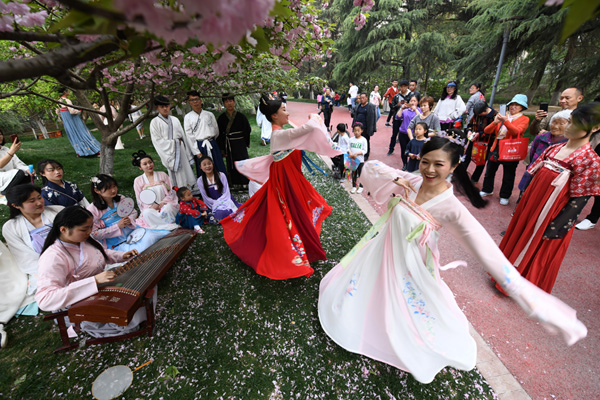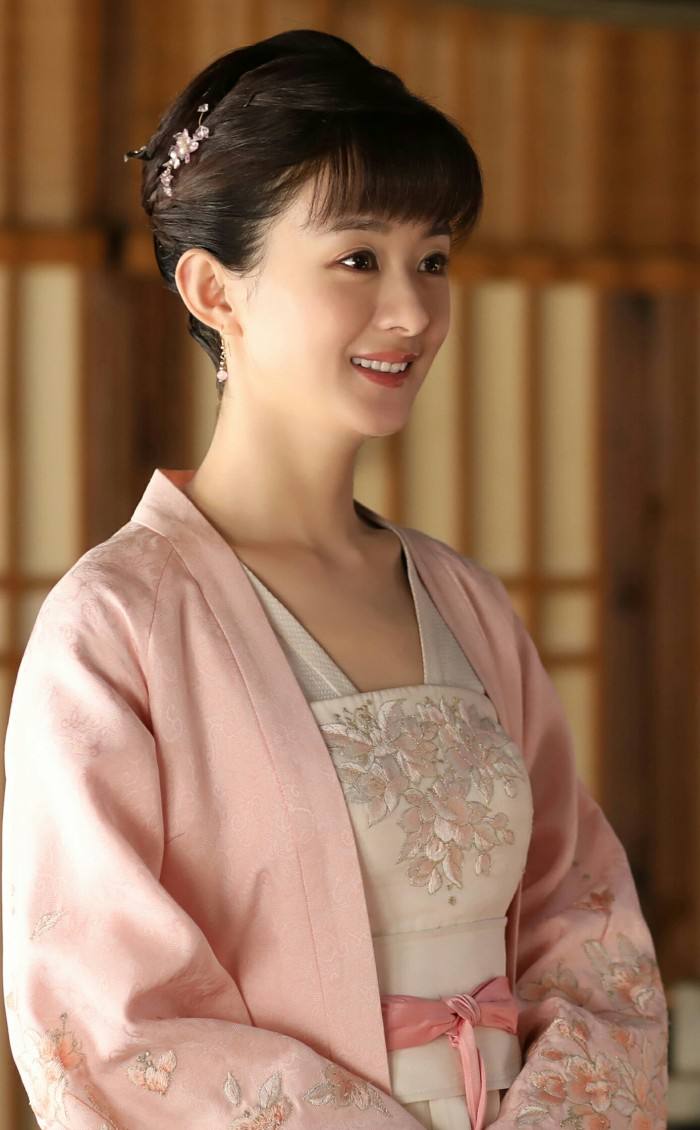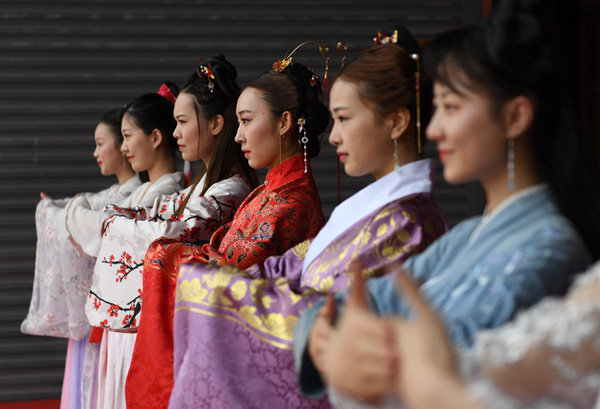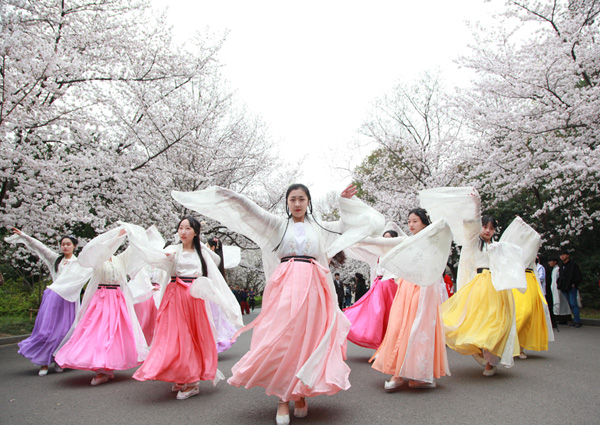

衣袂當風,裙帶輕飄……當下,“漢服熱”愈發升溫,在城市的大街小巷尤其是熱門旅遊景點,越來越多的人身著漢服出行。有人因漢服外觀好看而對其著迷,也有人熱衷於其背後的深厚文化內涵。來看看法新社對這一文化現象的報道。

College students wear traditional hanfu clothing as they dance at a park in Fuyang, Anhui province, in April. [Photo provided to China Daily]
Dressed in a flowing long robe adorned with beaded floral embroidery from a bygone era, stylist Xiao Hang looks like she surfaced from a time machine as she strides across the bustling Beijing metro, attracting curious glances and inquisitive questions.
身穿一件以珠子和繡花裝飾的古代飄逸長袍,設計師肖航(音)仿佛剛剛從一台時間機器裏走出來,穿行在熙熙攘攘的北京地鐵裏,引來好奇的目光和追問。
embroidery [ɪm'brɒɪd(ə)rɪ; em-]:n.刺繡;刺繡品
China has embraced Western fashion and futuristic technology as its economy boomed in recent decades, but a growing number of young people like Xiao are looking to the past for their sartorial choices and donning traditional "hanfu", or "Han clothing".
在過去幾十年裏,隨著中國經濟繁榮發展,中國人接受了西方的時尚和先進的未來技術,但是越來越多的像肖航這樣的年輕人開始在穿著打扮上追求復古,穿起了傳統的漢服。
These historic costumes of the Han ethnic majority are enjoying a renaissance in part because the government is promoting traditional culture.
漢服這種歷史服飾正迎來復興,這在一定程度上是因為政府致力於推廣傳統文化。
renaissance [rɪˈneɪsns]:n.(藝術等的)新生,復活

[Photo/The Story of Minglan]
Period dramas have also contributed to the surge in interest for traditional Chinese garb -- "The Story of Minglan", a TV series set in the Song Dynasty, garnered more than 400 million viewers in three days when it debuted earlier this year.
此外,一些古裝電視劇的熱播也激發了人們對中國傳統服飾的興趣。今年初,以宋朝為背景的古裝電視劇《知否知否應是綠肥紅瘦》首播後,三天內就吸引到了超過4億觀眾。
There is no uniform definition of what counts as hanfu since each Han-dominated dynasty had its own style, but the outfits are characterized by loose, flowing robes that drape around the body, with sleeves that hang down to the knees.
漢服沒有統一的定義,因為漢人統治的每個朝代都有自己的風格,但漢服的共同特徵是寬鬆飄逸的披身長袍和長至膝蓋的袖子。
drape[dreɪp]:vi.成褶皺狀垂下
"When we were little, we would also drape sheets and duvets around ourselves to pretend we were wearing beautiful clothes," Xiao told AFP.
肖航告訴法新社記者説:“我們小時候也會用床單和被子把自己包起來,假裝穿的是漂亮衣服。”
Xiao, who used to work at a state-owned machine manufacturing company, now runs her own hanfu business, where she dresses customers for photo shoots and even plans hanfu-style weddings.
曾在一家機械製造國企工作的肖航現在經營漢服生意,主要是為漢服攝影顧客提供服裝搭配服務,有時還會策劃漢服形式的婚禮。

[Photo provided to China Daily]
古裝范,新時尚
In modern China, the hanfu community spans the gamut: from history enthusiasts to anime fans, to students and even young professionals.
在現代中國,漢服愛好者遍及各個領域:從歷史愛好者到動漫迷,再到學生甚至是年輕的職場人士。
gamut ['gæmət]:n.整個範圍
Yang Jiaming, a high school student in Beijing, wears his outfit under his school uniform.
北京高中生楊佳明(音)把他的古裝穿在校服裏面。
"Two-thirds of my wardrobe is hanfu," he said, decked out in a Tang-style beige gown and black boots at a hanfu gathering, adding that his classmates and teachers have been supportive of his style.
他穿著唐代樣式的米色長袍和黑色靴子參加一場漢服聚會。他説:“我的衣櫥裏有三分之二是漢服。”他還説,他的同學和老師都支援他的穿衣風格。
deck out:裝飾,打扮;盛裝打扮
beige[beɪʒ; beɪdʒ]:adj.淺褐色的;米黃色的
Clothes are the "foundation of culture," said Jiang Xue, who is part of Beijing-based hanfu club Mowutianxia.
位於北京的漢服社團墨舞天下的成員江雪(音)説,衣著是“文化的基礎”。
"If we as a people and as a country do not even understand our traditional clothing or don't wear them, how can we talk about other essential parts of our culture?" she said.
她説:“如果我們作為一個民族、一個國家甚至不了解我們的傳統服裝或者不穿它們,我們怎麼去談論我們文化的其他重要部分?”

[Photo provided to China Daily]
奇裝異服?
There is some way before the style reaches mainstream acceptance in China.
不過,這種風格要在中國得到主流認可還有一段路要走。
Others say they're deterred by the odd looks they get when wearing hanfu in public.
有人表示,公共場合的異樣目光讓他們不敢穿漢服。
deter [dɪ'tɜː]:vt.制止,阻止;使打消念頭
"I used to be very embarrassed to wear (hanfu) out," screenwriter Cheng Xia told AFP.
編劇程夏(音)告訴法新社記者説:“我以前穿著漢服出去感到很尷尬。”
Yang, the high school student, is more upbeat.
然而,高中生楊佳明卻更加樂觀。
He said: "At the very least, we can wear our own traditional clothes."
他説:“至少,我們可以穿自己的傳統服裝。”
來源:法新社、參考消息網
翻譯&編輯:yaning